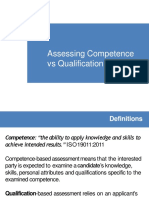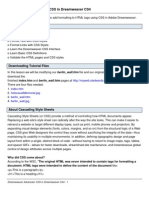ISO 9000 A Stepping Stone To Total Quality Management
ISO 9000 A Stepping Stone To Total Quality Management
Uploaded by
Marcus Skookumchuck VanniniCopyright:
Available Formats
ISO 9000 A Stepping Stone To Total Quality Management
ISO 9000 A Stepping Stone To Total Quality Management
Uploaded by
Marcus Skookumchuck VanniniOriginal Description:
Original Title
Copyright
Available Formats
Share this document
Did you find this document useful?
Is this content inappropriate?
Copyright:
Available Formats
ISO 9000 A Stepping Stone To Total Quality Management
ISO 9000 A Stepping Stone To Total Quality Management
Uploaded by
Marcus Skookumchuck VanniniCopyright:
Available Formats
Seventh LACCEI Latin American and Caribbean Conference for Engineering and Technology (LACCEI’2009)
“Energy and Technology for the Americas: Education, Innovation, Technology and Practice”
June 2-5, 2009, San Cristóbal, Venezuela.
ISO 9000: A Stepping Stone to Total Quality Management for
Construction Companies?
Rizwan U. Farooqui
Florida International University, Miami, Florida, USA, rfaro001@fiu.edu
Syed M. Ahmed
Florida International University, Miami, Florida, USA, ahmeds@fiu.edu
ABSTRACT
As construction projects get bigger and more complex, clients are increasingly demanding higher levels of
quality, efficiency, and delivery. Total Quality Management (TQM) has long been recognized as a successful
management philosophy in the manufacturing and service industries. TQM can also be embraced in the
construction industry to help raise quality and productivity. This report attempts to introduce the basic elements of
ISO 9000 and describes how each can be implemented in a wide array of construction-related companies, in order
to achieve their goal of total quality. Numerous case studies were found which demonstrate the ability of ISO
9000 to improve a company's quality performance, avoid costly errors, and produce satisfied customers. For the
purpose of this report, two case studies are discussed showing how construction companies can successfully
implement TQM. The benefits experienced include reduction in quality costs, better employee job satisfaction
because they do not need to attend to defects and client complaints, recognition by clients, work carried out
correctly right from the start, subcontractors with proper quality management systems, and closer relationships
with subcontractors and suppliers. TQM performance measures were also reflected through top management
commitment, customer involvement and satisfaction, employee involvement and empowerment, customer–
supplier relationships, and process improvement and management. Finally, a framework for implementing TQM
in construction is recommended.
Keywords: Total Quality Management, ISO 9000.
1. INTRODUCTION
Companies are being persuaded to adopt quality management systems in order to meet the demands of customers
in a global market. ISO 9000, a series of international quality management standards, has emerged during the last
two decades as a system that can be applied to different types of companies in order to obtain improvements in
quality procedures and products. ISO 9000 is being implemented all over the world as a system of standards
related to quality assurance management and control for companies and institutions. ISO 9000 certification in the
construction industry has been widely accepted in many countries, and the number of certifications for general,
heavy and specialty contracting companies is growing considerably. Some investigators associate ISO 9000 with
multiple advantages and with positive changes in internal procedures of construction firms. Yet others argue that
these standards do not apply directly to the construction industry and cannot be associated with a substantial
improvement in the delivery of a quality construction product.
The success of the ISO 9000 family of standards is still growing and the number of countries where ISO 9000 is
being implemented has increased. Over 400,000 companies in 158 countries have identified the ISO 9000
standard as a strategic management tool essential to effective control and best business practice. The construction
industry has embraced the ISO 9000 standard since its inception. The Quality Management standard has become
the benchmark for successful construction companies. The discipline and systematic approach has helped many
companies to structure their management and processes to consistently meet the client’s requirements. The
San Cristóbal, Venezuela June 2-5, 2009
7th Latin American and Caribbean Conference for Engineering and Technology
WE1-1
revised ISO 9001: 2000 standard places greater emphasis on customer needs and expectations and improving
business performance and is now easily applied to a construction companies operations.
2. BACKGROUND
The ISO 9000 series was originated from the military procurement standards in the Second World War, which
ultimately led to the first civil quality management standard: BS 5750 of the British Standards Institution in 1979.
In 1987, the British Standard BS 5750 was adapted with a few modifications and turned into the international
standard of ISO 9000. Although the international standard was updated in 1994, there was not much change until
the new version in 2000, which to certain extent is a complete rewrite.
The success of the ISO 9000 family of standards is still growing and the number of countries where ISO 9000 is
being implemented has increased. Over 400,000 companies in 158 countries have identified the ISO 9000
standard as a strategic management tool essential to effective control and best business practice. The standard
specifies six compulsory documents:
• Control of Documents
• Control of Records
• Internal Audits
• Control of Nonconforming Product / Service
• Corrective Action
• Preventive Action
In addition to these, ISO 9001:2000 requires a Quality Policy and Quality Manual (which may or may not include
the above documents). The ISO 9000:1994 standards consist of three auditable certification standards as ISO
9001/2/3. These apply correspondingly to organizations which:
1. Design their own products and services (20 clauses),
2. Do everything with the exception of design (19 clauses), and
3. Provide products and services that can be verified only by inspection and test (16 clauses).
The ISO 9001:2000 standards integrate these three elements into ISO 9001, which places stronger emphasis on
process management and resource management, and has commonality of architecture with ISO 9004, so that
quality assurance requirements and quality management can be aligned holistically.
One of the biggest changes in ISO 9001:2000 is that the new concepts of process approach management are
promoted. The process approach management is defined as "the application of a system of processes within an
organization, together with the identification and interactions of these processes, and their management" (Biazzo
and Bernardi, 2003). This approach is significantly different from ISO 9000:1994; under the new standard,
organizations must identify processes within the quality system, including interactions, manage and control them
to the compliance with the requirements. This change of the ISO 9001:2000 standard is significant for
construction firms. In the construction industry, the final product is produced by activities in a process and the
construction process does not follow a production line as the manufacturing industry does but is composed of
concurrent activities in a construction site, such as concreting, bar fixing and formwork erecting. The documented
procedures form the biggest bureaucrat in controlling the processes/activities.
The revised ISO 9001: 2000 standard places greater emphasis on customer needs and expectations and improving
business performance and is now easily applied to a construction companies operations. The eight Quality
Management Principles stated in ISO 9000:2000 and ISO 9004:2000 provide the basis for the performance
improvement (see Table 1).
San Cristóbal, Venezuela June 2-5, 2009
7th Latin American and Caribbean Conference for Engineering and Technology
WE1-2
Table 1: ISO 9001: 2000 Principles
EIGHT BASIC CONCEPTS RESULTS
Focusing on the Customer Increased revenue and market share.
Choose Effective Leaders Motivation towards achieving organizational goals
Involving People Fostering innovation, creativity and accountability
Systematically defining the activities necessary to
Understanding Processes
obtain a desired result
Structuring a system to achieve the organization’s
Valuing a Systems Approach
objectives in the most effective and efficient way
Making continual improvement of products,
Looking for Continual Improvement processes and systems an objective for every
individual in the organization
Exercising Good Judgment Informed decisions
Recognizing Common Cause Increased ability to create value for both parties
KEY CHANGES IN THE REVISED ISO 9001: 2000 STANDARDS
The key changes in the revised ISO 9001: 2000 document as compared to previous versions of ISO standards are
summarized below. These changes highlight the move of ISO towards implementing TQM.
• Number of standards reduced and simplified.
• Restructured on a business process model in tune with the way organizations actually work.
• Now measures customer satisfaction.
• Expands and reinforces management responsibilities and communication skills.
• Helps companies make continual explicit improvement.
• Language less manufacturing oriented and more user-friendly.
• Reduces the need for documented procedures, with increased emphasis on training and competence.
• Requires involvement throughout the organization - managing quality and quality management.
A literature review of the standards’ potential and contribution towards total quality management proved to be
dichotomized, and the main conclusion that is drawn (Carlsson and Carlsson, 1996; Mayer, 1993; Stephens, 1997;
Taylor, 1995; Tummala and Tang, 1996; Tsiotras and Gotzamani, 1996) is that the standards’ long-term
contribution to the certified companies may be positive, neutral or negative, depending on the way that companies
choose to implement them. The success or failure of the standards does not depend on the adequacy of their
requirements alone, but rather on the companies’ ability and willingness to implement them correctly.
Certification alone without the proper development and continuous improvement of a dynamic quality assurance
system, continuously adapting to the variable external requirements, cannot bring the positive results expected to
provide the basis for future adoption of TQM.
ISO 9000: A WAY OF MANAGING FOR CONFORMANCE
Quality assurance, according to the Standard, is a way of managing that prevents non-conformance and thus
“assures quality”. This is what makes ISO 9000 different from other standards: it is a management standard, not a
product standard. It goes beyond product standardization: it is standardizing not what is made but how it is made.
To use standards to dictate and control how organizations work was to extend the role of standards to new
territory. To take such a step we might have firstly established that any such requirements worked — that they
resulted in ways of working which improved performance.
3. QUALITY CONTROL IN THE CONSTRUCTION INDUSTRY
Quality is probably one of the most important competitive weapons in today’s unpredictable and competitive
markets. In the general context of management, quality is defined as:
San Cristóbal, Venezuela June 2-5, 2009
7th Latin American and Caribbean Conference for Engineering and Technology
WE1-3
“The totality of features and characteristics of a product that bears on its ability to satisfy stated or implied
needs.” (ISO 1994A, Chung, 1999)
Quality is an elusive and indistinct tool, yet despite plenty of writing on the subject; quality can still be defined
differently to fit a particular business situation, organization, or customer. However, construction quality in
particular, can be seen as very difficult to define due to the uniqueness of its construction methods, product and
work force that can be involved in a single project. Unlike a normal product, which can be taken back to the
production line if it does not meet the requirements, the construction product is usually in the form of a project,
which, once built, is irreversible. It is a one of the unique undertakings that is constrained by the ever-present goal
of meeting time, cost and performance. These three are inextricably linked, such that altering one, will
undoubtedly have an effect on the others. In the construction industry, required performance can be said to
represent quality, which means quality can be simply described as: “conformance to requirements.”
Despite different interpretations of quality by quality experts, one cannot avoid seeing how quality has developed
into the most important competitive weapon these days. In construction, the nature of a project implies that there
will be several different professionals and tradesmen responsible for the finished building product. As a result, if
an error was to appear years later, it would be difficult to identify the source of the problem. Therefore, the
different professionals working on a project need to have separate quality management systems that will assure
adherence to the contractual requirements.
In an industry that has for a long time been ‘viewed as resistant to change and benchmarked internationally as
simply uncompetitive,’ quality initiatives must be embraced in order to shake off such an image, which prevents
construction companies from gaining a competitive advantage internationally. Quality needs to become the new
business philosophy of any organization.
4. ISO 9000 AND THE CONSTRUCTION INDUSTRY
A formal quality management system has the potential to change attitudes, cultures, and work procedures at any
construction firm in a way the organization has never experienced before. In most cases, in order to set up a
formal quality management system at a construction firm, there has to be direct demands from their customers,
whose requirement for quality is essential for doing business. Most of the construction organizations will not enter
into the cost and allocation of resources to implement a quality management system unless they will be
compensated. There is a general movement towards making implementation of a quality management system a
contractual requirement. Small to medium sized organizations can always argue that they ‘operate to a quality
system’ although this is not formalized. However, since the existence of such ‘informal’ quality systems are
difficult to justify, the International Standards Organization, (ISO) has come up with ISO 9001 series of standards
that are applicable to all organizations irrespective of size or nature of business.
ISO 9000 refers to a set of quality management standards. Standards present an opportunity for an organization to
develop a quality management system that meets the requirements specified by ISO 9001:2000, which are
recognized internationally, making the organization competitive. ISO 9001 family of standards is undeniably the
most prolific of all formal standards. This could be due to the worldwide applicability standardization and
flexibility with which the standards are associated, even though there are some experts that still question the
standards’ applicability in the construction industry. It is important to note that ISO 9001:2000 has replaced ISO
9001:1994, ISO 9002:1994 and ISO 9003:1994, while the old ISO 9002 and ISO 9003 standards have been
discontinued.
5. BENEFITS OF ISO 9000 FOR CONSTRUCTION COMPANIES
ISO 9000 certification will drive continual improvement and contribute to:
• Improvement in "bottom line" profit through:
o Better efficiency
San Cristóbal, Venezuela June 2-5, 2009
7th Latin American and Caribbean Conference for Engineering and Technology
WE1-4
o Continual improvement
o Waste Reduction
• Consistent and effective control of key processes and project management
• Promotion and standardization of good working practices
• Provision of a vehicle for training new employees
• Effective management of risk and reducing crisis management
• More effective data analysis, generation of key performance metrics and continual improvement
objectives
• Greater emphasis on communication, leadership, change management and adequacy of training
• A planning and review process which will ensure that the system in place remains suitable,
effective and capable of identifying new opportunities
• Effective remote site management, accountability and contractual control
• Promoting control of suppliers and subcontractors and the development of effective supply chain
management
• World-wide recognition
6. IMPLEMENTING ISO 9000 IN A CONSTRUCTION COMPANY
Deming has provided a seven point action plan as follows: Much research has been done with regard to the
implementation of TQM and it is belief that the benefits of higher customer satisfaction, better quality products,
and higher market share are often obtained following the adoption of TQM by construction companies. It requires
a complete turnaround in corporate culture and management approach As compared to the traditional way of top
management giving orders and employees merely obeying them. It is believed that the single most important
determinant of the success an organization in implementing TQM is its ability to translate, integrate, and
ultimately institutionalize TQM behaviors into everyday practice on the job. TQM is a way of thinking about
goals, organizations, processes, and people to ensure that the right things are done right the first time. It is a major
organizational change that requires a transformation in the culture, process, strategic priorities, beliefs, etc. of an
organization. The first question that a construction company must ask itself prior to implementing a formal quality
management system is ‘where should we start?’
The main challenge facing most construction companies understands what their first step is for implementing a
quality process. In developing a total quality culture in construction, one important step is to develop a
construction team of a main contractor and subcontractors who would commit to the quality process and develop
a true quality attitude. Thus, the main contractor should only select subcontractors who have demonstrated quality
attitude and work performance on previous jobs. The problem is that most quality management systems are not
meant for small to medium businesses, which comprise the majority of the construction firms in the U.S., who
neither have the structure nor the management time to support the recommended ‘top-down approach’ which suits
large companies, for which the quality manuals are written. In small to medium construction companies, this kind
of ‘top-down approach’ is criticized by Asher, (1998) who believes that like every quality management systems
before, applies only to large organizations. In his argument, small to medium construction companies neither have
the structure or the management time to support such implementation.
In short, small to medium construction companies are at a huge disadvantage in trying to implement quality
systems, due to their size, and the problems associated with being small. These do not have the management time
to support implementation; there is also, the issue of the cost of implementing the system itself, fear and inertia
that result from being owner-managed. At the same time, a study by Nwanko, (2000) found that implementing
quality management systems in most construction companies revolve around the ISO 9001-type implementation.
As mentioned before, the process of obtaining an ISO 9001:2000 certificate is not too complex. It involves putting
together the necessary documents to prove to the external auditor that the system exists.
San Cristóbal, Venezuela June 2-5, 2009
7th Latin American and Caribbean Conference for Engineering and Technology
WE1-5
On the other hand, critics of ISO 9001:2000 standard in small to medium construction companies agree that the
nature of the ISO 9001-type standard allows organizations to focus on short-term goals of obtaining a certificate,
failing to appreciate the organisational benefits, which could be obtained if the process of certification was not
seen as: ‘an end in itself.’ Given that the small to medium construction companies play such a critical role in
supporting the U.S. economy it has been implied that they could benefit from any performance enhancing
strategies such as the introduction of quality management systems. The reputation of small to medium
construction company’s procurement creates an environment that diverts effort from pursuing quality to the
defence of inefficiency, error and waste. Therefore, formal quality systems like the ISO 9001:2000 series are a
way of increasing customer confidence that the material, product or service will conform to specified
requirements.
7. CASE STUDIES
Two construction companies in Singapore who have implemented TQM in their organizations were studied. The
case studies aim to examine how each organization practices TQM and the tools used to assist them in doing so.
In addition, the methods of measuring the performance of TQM within each organization are presented. The
studies made use of interviews and reviews of relevant company publications in Singapore.
ORGANIZATION A
Organization A is a G8 Japanese contractor who has involved in local construction projects for more than 22
years. Construction companies in Singapore are registered with the Building and Construction Authority’s
Central Registry of Public Sector Contractors in one of eight financial categories. These range from G1, the
smallest, to G8, the largest financial category. The Management Representative, who has worked for the firm for
19 years, was interviewed for this case study. Organization A has won several quality awards before, including
one from a Japanese client for quality workmanship for a chemical plant project. This is not surprising because
the quality mission of the company has incorporated certain aspects of TQM that is to: ‘‘Provide quality
construction that meets customer requirements and continual improvement to enhance customer satisfaction.’’ At
the time of this study, Organization A was audited and awaiting certification to the ISO 9001:2000 standard. The
Management Representative highlighted that the ISO 9001:2000 standard emphasizes continual improvement and
is more systematic than the old ISO 9001:1994 standard which concentrated on documentation. Nevertheless, the
Management Representative admitted that the reason behind ISO 9001:2000 certification was largely motivated
by regulatory requirements in Singapore and not because it will help in TQM implementation in the first instance.
He added that the benefits of ISO 9001:2000 certification would be enjoyed most by organizations that were not
already certified to the ISO 9001:1994 standard.
ORGANIZATION B
A local G8 construction firm, Organization B is known for its high-quality standards in design-and-build projects.
The personnel interviewed were the Quality Systems Manager who has worked for Organization B for three
years. The firm seeks to adopt the ‘‘do it right the first time’’ approach and to strive for zero wastage and zero
defects. Like Organization A, Organization B is also committed to understanding the needs of its customers to
deliver quality products through a continual improvement process. At the time of this study, Organization B was
expected to obtain their certification to the ISO 9001:2000 standard in the third quarter of 2002. It was then
preparing for the ISO 9001:2000 audits. The Quality System Manager agreed that certification to the ISO
9001:2000 standard will help in facilitating continual improvement to allow Organization B to respond more
positively toward client needs and expectations. The Quality System Manager opined that organizations will only
carry out TQM principles that are required in the ISO 9001:2000 standards and that unless an organization is
aware of these principles, TQM will not be implemented in totality. The quality system manager noted that the
new ISO 9001:2000 standard focuses on process flow that can help to identify what needs to be controlled. This is
unlike the old ISO 9001:1994 standard which focused on individual quality elements, thus failing to highlight the
relationship between them.
San Cristóbal, Venezuela June 2-5, 2009
7th Latin American and Caribbean Conference for Engineering and Technology
WE1-6
ANALYSIS
Construction organizations should realize that results cannot be gained overnight and that an organization needs
time to adapt, change, and learn. The biggest hurdle for the organization is to change its status quo and develop a
culture that will support TQM. Commitment of top management is crucial in decision making and for successful
TQM implementation. Organization B appears to lack this commitment, which was why TQM was not fully
carried out. Both Organizations A and B have not used a statistical approach to TQM because they were not
familiar with statistical tools and felt that the time and resources needed to train their employees would be long
and tedious. When the decision to set up a company in Singapore was made, the headquarters of Organization A
in Japan sent their employees to Singapore to help with TQM education. Hence, Organization A started the
process of TQM implementation right from day one. It appears easier for a new organization to train its
employees in TQM practices than one whose employees already have fixed ways of doing things. In the latter,
TQM may be seen as an additional burden rather than to help them to improve quality. Hence, linking the two
case studies, it is clear that implementing TQM requires a major organizational change that would transform the
culture, processes, strategic priorities, and beliefs of an organization. Apart from commitment, top management
must educate its employees on the need for TQM and communicate clearly to them that TQM is not an additional
burden to the organization. Instead, TQM will help to reduce the amount of work for employees if they no longer
need to attend to customer complaints and defect problems. In summary, the two case studies confirmed that the
following factors are important considerations for TQM implementation: An understanding of TQM requirements
including customer/supplier involvement, continuous improvement, top management commitment, strategic
review of education and implementation plans, provision of ample budgets and resources, teamwork, training, and
timely feedback. Nevertheless, the limitation of the two case studies is that the two organizations were reluctant to
divulge information relating to their strategy used to implement TQM and details of their training programs. In
addition, the authors were also unable to interview the general managers of both organizations. Consequently, the
Management Representative of Organization A and Quality Systems Manager of Organization B were
interviewed instead. Although they may be able to provide appropriate information because of their in-depth
knowledge of quality systems, they may not be able to articulate other information such as those relating to top
management commitment.
8. CONCLUSIONS
Clearly, ISO 9000 can prove to be a great method of building a quality track record that will stand up under the
closest scrutiny, even in the most competitive construction environments. It enables all types of construction
professionals--from architects and engineers to contractors and suppliers--to develop quality standards and
procedures precisely suited to their particular needs and responsibilities. It offers step-by-step instructions on the
implementation and management of an ISO 9000 quality assurance system and demonstrates how the system puts
the quality-management process into effect before work begins and detects and corrects problems before they
reach disastrous proportions.
Companies with ISO 9000 certification are already given contract preference in Europe and Australia. It is likely
that within a few years the same will be true in North America. ISO 9000 compliance is rapidly becoming a
prerequisite for companies seeking international construction contracts, and the same may soon be true for firms
operating solely within North America. For architects, engineers, contractors, specifications workers, hardware
managers, and other professionals in construction-related industries, ISO 9000 in Construction is the key to
achieving more consistent performance levels, improved efficiency and productivity, a solid reputation for
quality, and a sharper competitive edge.
The list below shows how ISO 9000 certification will drive continual improvement and contribute to
improvements in "bottom line" profit:
9 Better efficiency
9 Continual improvement
San Cristóbal, Venezuela June 2-5, 2009
7th Latin American and Caribbean Conference for Engineering and Technology
WE1-7
9 Waste Reduction
9 Consistent and effective control of key processes and project management
9 Promotion and standardization of good working practices
9 Provision of a vehicle for training new employees
9 Effective management of risk and reducing crisis management
9 More effective data analysis, generation of key performance metrics and continual improvement
objectives
9 Greater emphasis on communication, leadership, change management and adequacy of training
9 A planning and review process which will ensure that the system in place remains suitable , effective and
capable of identifying new opportunities
9 Effective remote site management, accountability and contractual control
9 Promoting control of suppliers and subcontractors and the development of effective supply chain
management
9 World-wide recognition
REFERENCES
Asher, J.M (1998) Implementing TQM in small and medium sized companies. Hertfordshire, Technical
Communications Limited.
Baden-Hallard, R. (1993). Total quality in construction projects, Thomas Telford, London.
Biggar, J. L. (1990). “Total quality management in construction.” Trans. Am. Assn. Cost Eng., August, 14(1), 1-
4.
Brown, M. G., Hichcock, D. E., and Willard, M. L. (1994). Why total Quality management fails and what to do
about it, Irwin, New York.
Burati, J. L., and Oswald, T. H. (1993). ‘‘Implementing total quality management in engineering and
construction.’’ J. Manage. Eng..
Chase, G. W. (1993). ‘‘Effective total quality management process.’’
Chileshe, N. (1996). ‘‘An investigation into the problematic issues associated with the implementation of Total
Quality Management within a
Chung, H.W. (1999) Understanding Quality Assurance in Construction – A practical guide to ISO 9000, London,
E&FN Spon
Constructional operational environment and the advocacy of their solutions.’’ M.Sc .dissertation, Sheffield
Hallam University, U.K.
Costin, H. (1994). Readings in total quality management, Dryden, New York.
Culp, G. (1993). ‘‘Implementing total quality management in consulting engineering firm.’’ J. Manage. Eng.,
9~4), 340–355.
Dale, B. G. (1994). Managing quality, 2nd Ed., Prentice-Hall, New York.
Nwanko, S. (2000) Quality assurance in small organisations: myths and reality. The TQM Magazine
http://www.cif.ie/asp/section.asp?s=704
San Cristóbal, Venezuela June 2-5, 2009
7th Latin American and Caribbean Conference for Engineering and Technology
WE1-8
http://findarticles.com/p/articles/mi_hb017/is_1_48/ai_n29174662
http://en.wikipedia.org/wiki/ISO_9001
Authorization and Disclaimer
Authors authorize LACCEI to publish the paper in the conference proceedings. Neither LACCEI nor the editors
are responsible either for the content or for the implications of what is expressed in the paper.
San Cristóbal, Venezuela June 2-5, 2009
7th Latin American and Caribbean Conference for Engineering and Technology
WE1-9
You might also like
- PWC - Remediation Letter 1 - 19 May 2023Document7 pagesPWC - Remediation Letter 1 - 19 May 2023AFR Newsroom100% (1)
- Circular 73 2008Document18 pagesCircular 73 2008Samuel Mavu100% (2)
- Paint Certf.Document1 pagePaint Certf.GustiKetutNo ratings yet
- Draft QMSDocument4 pagesDraft QMSChandra RaoNo ratings yet
- Construction - Method Statement Format - I Whattam 2007Document2 pagesConstruction - Method Statement Format - I Whattam 2007alaaNo ratings yet
- Norway Joint Venture Audit GuidelinesDocument31 pagesNorway Joint Venture Audit GuidelinesPatekJoaquinNo ratings yet
- Ra 9105Document4 pagesRa 9105Nina L. Dela CruzNo ratings yet
- 4quality Tools Technique Used by Company WiproDocument10 pages4quality Tools Technique Used by Company WiproSushil JaiswalNo ratings yet
- Sequence and Interaction Process 1Document5 pagesSequence and Interaction Process 1desurkarbNo ratings yet
- Appendix H Project Completion Report: SECTION A: Project ProfileDocument3 pagesAppendix H Project Completion Report: SECTION A: Project Profileflee2yasirNo ratings yet
- WBI T06 Rev00 Management of ChangeDocument2 pagesWBI T06 Rev00 Management of ChangeKunal SinghNo ratings yet
- Audit Schedule and PlanDocument2 pagesAudit Schedule and PlaniahmedamNo ratings yet
- Iso 45001Document1 pageIso 45001Ranjith jNo ratings yet
- Attachment1 - WNL Quality Procedures: Wilkriss Nigeria LimitedDocument3 pagesAttachment1 - WNL Quality Procedures: Wilkriss Nigeria LimitedlupiNo ratings yet
- Appendix A Sample Floating Dry Dock Inspection Checklist: Safe Operation and Maintenance of Dry Dock FacilitiesDocument7 pagesAppendix A Sample Floating Dry Dock Inspection Checklist: Safe Operation and Maintenance of Dry Dock FacilitieswaleedyehiaNo ratings yet
- 03 Integrated Management System Manual Integrated Preview enDocument5 pages03 Integrated Management System Manual Integrated Preview enkoalaboiNo ratings yet
- Job Description For Quality Assurance ManagerDocument3 pagesJob Description For Quality Assurance ManagerTarunKumarNo ratings yet
- RISK Mba 17Document22 pagesRISK Mba 17Cecily Sandra100% (1)
- Structural Integrity Management Cranfield UniversityDocument4 pagesStructural Integrity Management Cranfield UniversityAndreasNo ratings yet
- CH 2Document18 pagesCH 2suresh84123No ratings yet
- SowDocument40 pagesSowPerfectionistSushantNo ratings yet
- Supplier Survey Form: InstructionsDocument6 pagesSupplier Survey Form: InstructionsFitra RamdhaniNo ratings yet
- Management Responsibility Draft 4 10 March 2014Document101 pagesManagement Responsibility Draft 4 10 March 2014mkpqNo ratings yet
- Assumption Log Template PDFDocument3 pagesAssumption Log Template PDFYahia Mustafa AlfazaziNo ratings yet
- Audit Notification - COOPERDocument2 pagesAudit Notification - COOPERnisha_khanNo ratings yet
- Iso 9001 - 2015 ALISONDocument5 pagesIso 9001 - 2015 ALISONAymane LAKHALNo ratings yet
- 02-012 Working at Heights PolicyDocument7 pages02-012 Working at Heights PolicyJoachimNo ratings yet
- Pdo Hse PolicyDocument1 pagePdo Hse Policyabdel-rahman emaraNo ratings yet
- ISO 9001 - 2015 Draft StandardDocument29 pagesISO 9001 - 2015 Draft Standardkesavchinna0% (1)
- Lessons Learned PDFDocument4 pagesLessons Learned PDFAmira NabillaNo ratings yet
- Human Resource Management: Balanced Score CardDocument34 pagesHuman Resource Management: Balanced Score CardLumi LuminitaNo ratings yet
- Gap AnalysisDocument30 pagesGap AnalysisSajal JainNo ratings yet
- Qhse Management System Manual: UNI EN ISO 9001:2015 UNI EN ISO 14001:2015 BS OHSAS 18001:2007 EN ISO/IEC 80079-34:2012Document43 pagesQhse Management System Manual: UNI EN ISO 9001:2015 UNI EN ISO 14001:2015 BS OHSAS 18001:2007 EN ISO/IEC 80079-34:2012das_joydebNo ratings yet
- Competence Vs QualificationDocument25 pagesCompetence Vs Qualificationjohnoo7No ratings yet
- PM Audit QuestionnaireDocument26 pagesPM Audit QuestionnaireAbdulGhaffarEshaqAlKhajah100% (1)
- Life Saving Rules FAQsDocument7 pagesLife Saving Rules FAQsArulboy123100% (1)
- BB.G VSP Pve Ed 00 PM Man 001 Rev 0Document20 pagesBB.G VSP Pve Ed 00 PM Man 001 Rev 0Brewer House100% (1)
- Office Safety HSE Presentation HSE FormatsDocument28 pagesOffice Safety HSE Presentation HSE Formatsகண்ணன் ரவிச்சந்திரன்No ratings yet
- 14k Gap GridDocument13 pages14k Gap GridMansoor AliNo ratings yet
- Integrated Management System PolicyDocument2 pagesIntegrated Management System PolicyPrincessAntonetteDeCastroNo ratings yet
- 2015 Quality Management PlanDocument9 pages2015 Quality Management PlanBea MokNo ratings yet
- Safety Culture Assessment Tool Analysis FormDocument1 pageSafety Culture Assessment Tool Analysis FormKhaled RamzyNo ratings yet
- Iso Awareness Weekend Staff Training Programme: RegistrationDocument12 pagesIso Awareness Weekend Staff Training Programme: RegistrationKakira Lions ClubNo ratings yet
- Exxon Oil MSDS - 744003Document10 pagesExxon Oil MSDS - 744003Qu EnNo ratings yet
- PPS HSE Internal PolicyDocument25 pagesPPS HSE Internal PolicyPioneer Power SystemsNo ratings yet
- CP-190 2014 Quality Management System For Project Delivery - Code of PracticeDocument40 pagesCP-190 2014 Quality Management System For Project Delivery - Code of Practicenickcho100% (1)
- Chevron: Chevron Enhances Safety Culture With Enterprise-Wide Incident Analysis and Reporting SystemDocument2 pagesChevron: Chevron Enhances Safety Culture With Enterprise-Wide Incident Analysis and Reporting SystemBrian HughesNo ratings yet
- ISO 9001:2015 ISO 14001:2015: 4 Context of The Organization 4 Context of The OrganizationDocument1 pageISO 9001:2015 ISO 14001:2015: 4 Context of The Organization 4 Context of The OrganizationMoonsoul ChildNo ratings yet
- Quality Management Final OutputDocument16 pagesQuality Management Final OutputMary Lynn Dela PeñaNo ratings yet
- CH 2 Project CycleDocument16 pagesCH 2 Project CycleMebratu SimaNo ratings yet
- Definition of QualityDocument11 pagesDefinition of QualityHerry SinagaNo ratings yet
- Internal AuditDocument36 pagesInternal Auditbhaveshh1No ratings yet
- Espoo ReportDocument38 pagesEspoo Reportraka9009No ratings yet
- ISO 9001 2015 Readiness ChecklistDocument9 pagesISO 9001 2015 Readiness ChecklistMohamed EzzatNo ratings yet
- ESCL-QPS-01, Quality Policy StatementDocument1 pageESCL-QPS-01, Quality Policy StatementadiqualityconsultNo ratings yet
- Internal Audit ProcedureDocument1 pageInternal Audit ProcedureXi MoNo ratings yet
- For Safe Backing & Equipment Blind Spots: The IssueDocument2 pagesFor Safe Backing & Equipment Blind Spots: The IssueSammie WilliamsNo ratings yet
- Tutor XML GxsDocument19 pagesTutor XML GxsraghuvlkNo ratings yet
- 3 Age Dependent Type 1 Diabetes Pa Tho GenesisDocument29 pages3 Age Dependent Type 1 Diabetes Pa Tho GenesisMarcus Skookumchuck VanniniNo ratings yet
- Bullshitters Anonymous OverviewDocument26 pagesBullshitters Anonymous OverviewMarcus Skookumchuck Vannini100% (1)
- New England Forest Products SBA PresentationDocument52 pagesNew England Forest Products SBA PresentationMarcus Skookumchuck VanniniNo ratings yet
- Dream Weaver Advanced CSS CS4Document13 pagesDream Weaver Advanced CSS CS4Marcus Skookumchuck VanniniNo ratings yet
- Tabs With Photoshop and CSSDocument3 pagesTabs With Photoshop and CSSMarcus Skookumchuck VanniniNo ratings yet
- Social Tagging As A Search StrategyDocument112 pagesSocial Tagging As A Search StrategyMarcus Skookumchuck VanniniNo ratings yet
- Css Quick Reference ManualDocument2 pagesCss Quick Reference ManualdevenunaNo ratings yet
- CSS Quick Reference GuideDocument3 pagesCSS Quick Reference GuideMarcus Skookumchuck VanniniNo ratings yet
- CSS 502 Programming Assignment #1Document1 pageCSS 502 Programming Assignment #1Marcus Skookumchuck VanniniNo ratings yet
- June 10 Notable Quotes, Events, Deaths & BirthsDocument2 pagesJune 10 Notable Quotes, Events, Deaths & BirthsMarcus Skookumchuck VanniniNo ratings yet
- CSS OverviewDocument3 pagesCSS OverviewMarcus Skookumchuck VanniniNo ratings yet
- June 9 Notable Quotes, Events, Deaths & BirthsDocument3 pagesJune 9 Notable Quotes, Events, Deaths & BirthsMarcus Skookumchuck VanniniNo ratings yet
- Desdemona and BiancaDocument5 pagesDesdemona and Biancamahima97No ratings yet
- Ancient WisdomDocument7 pagesAncient WisdomGhud Handang100% (1)
- BUSM4403B Assignment 2 Group 1 1Document10 pagesBUSM4403B Assignment 2 Group 1 1Duy Anh NguyenNo ratings yet
- SF10 (Card) GS 2022-2023Document3 pagesSF10 (Card) GS 2022-2023PeterClomaJr.No ratings yet
- Ws CitizenshipinthecommunityDocument5 pagesWs CitizenshipinthecommunityJael CañedoNo ratings yet
- Literature Review - EditedDocument4 pagesLiterature Review - EditedAli GilaniNo ratings yet
- Hastening Ills A Prey,/where Wealth Accumulates, and Men DecayDocument3 pagesHastening Ills A Prey,/where Wealth Accumulates, and Men DecayGeorgiana GiusepiNo ratings yet
- Eat That Frog BookDocument14 pagesEat That Frog BookDivyanshu JoshiNo ratings yet
- International Political Economy (IPE)Document36 pagesInternational Political Economy (IPE)Evan Noor100% (4)
- NSW Bar Association Annual Report 2012-13Document104 pagesNSW Bar Association Annual Report 2012-13tffreemanNo ratings yet
- 10commandments of Computer EThicsDocument2 pages10commandments of Computer EThicsDanielBrighamAlbaniaQuintoNo ratings yet
- E Book Competency Dictionary For The Civil ServicesDocument40 pagesE Book Competency Dictionary For The Civil Servicesssikarwar92100% (1)
- Psychosocial Case Study FormatDocument3 pagesPsychosocial Case Study FormatLoh Wei Chieh0% (1)
- CH 21 Multiple Choice Flashcards - QuizletDocument23 pagesCH 21 Multiple Choice Flashcards - Quizletdraga pinasNo ratings yet
- Saint NovenasDocument78 pagesSaint NovenasteresapulgaNo ratings yet
- The Ecstasy by John Donne NotesDocument3 pagesThe Ecstasy by John Donne Notesapi-231816447100% (1)
- F 2848Document2 pagesF 2848IRS100% (1)
- Alex Grech: Week #19 Alt-MBADocument35 pagesAlex Grech: Week #19 Alt-MBAAmit ShaliNo ratings yet
- SNM Academy - IAS Coaching in ChandigarhDocument21 pagesSNM Academy - IAS Coaching in ChandigarhsnmacademyNo ratings yet
- Farrugia v. MaltaDocument39 pagesFarrugia v. MaltaAnaGeoNo ratings yet
- Certificate Mca InternshipDocument3 pagesCertificate Mca Internshipmindworkz proNo ratings yet
- Wife of Bath - Character AnalysisDocument3 pagesWife of Bath - Character AnalysisReal King100% (1)
- Academic IntegrityDocument4 pagesAcademic IntegrityAngela Marcela López RendónNo ratings yet
- Synthesis Chapter 2 First HalfDocument6 pagesSynthesis Chapter 2 First HalfPrincess EngresoNo ratings yet
- Paper Iii Advance Educational Psychology Unit IDocument149 pagesPaper Iii Advance Educational Psychology Unit IGrey White.No ratings yet
- Solidarity Economy Building Alternatives For People and PlanetDocument441 pagesSolidarity Economy Building Alternatives For People and PlanetEranonymous100% (1)
- 2017 GCDP Position Paper Opioid Crisis ENGDocument20 pages2017 GCDP Position Paper Opioid Crisis ENGBenjamin CMNo ratings yet






































































































